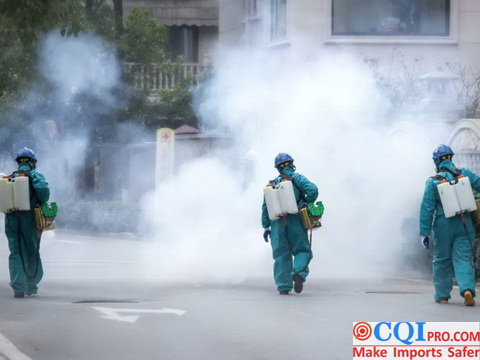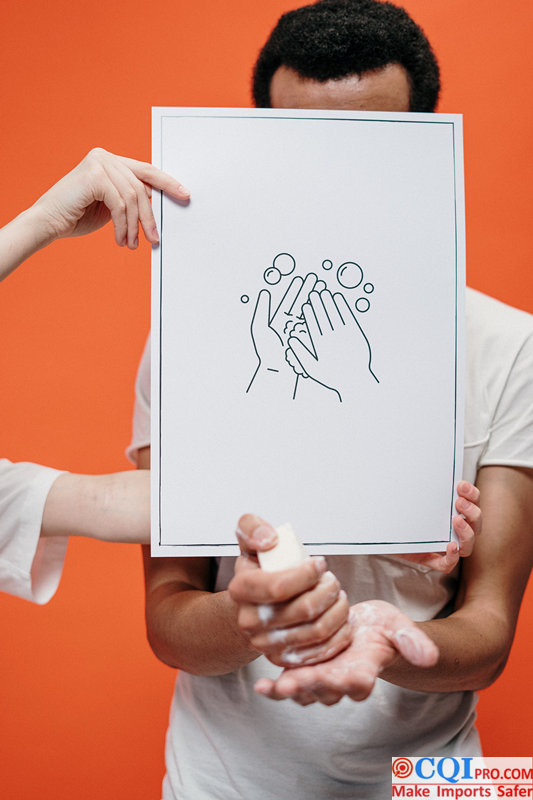The Last Madness of Sanitizer
By For Safer Imports • 07/15/2021 • No Comments
In the case of global shortage epidemic prevention materials, the “epidemic prevention status” of sanitizer is second only to masks
Employees are working 24 hours.In order to donate materials to epidemic areas as soon as possible. Some enterprises resumed production during the Spring Festival. In response to the government’s call for epidemic prevention and control, the factory has started the “full load” mode. And all the executives, employees and even clients have directly worked on the sanitizer production line.
Looking back at history, this “scene of boom and prosperity” in Chinese sanitizer industry is not the first time. During SARS in 2003, sanitizer was also out of stock. But as the epidemic came to an abrupt end, the sanitizer sales dropped rapidly. Despite the rise of Dettol and Walch in China, they have entered thousands of households, but in most cases there is a large backlog of sanitizer from numerous small and medium-sized manufacturers.

According to China Liby Group, the sales of sanitizer products such as sterilization and bacteriostasis is not high compared with products such as laundry detergent and detergent. However, in the past half month, the ordering demand of anti-virus and fungus-removing products from dealers around the country has continued. The outbreak of the epidemic in China coincided with the Spring Festival in China. And there was insufficient inventory and worker shortage. Sanitizer production in China forced the manufacturers to make every effort. Packaging materials, raw material preparation and logistics transportation are all headaches for enterprises. When rushing to buy sanitizer packaging bottles, it is the same as rushing to buy masks. A bottle goes up from 0.3 to 0.4 yuan to one yuan, but manufacturers can’t hesitate, because if they place an order one minute later, there is nothing left.
Almost all the pressure is concentrated on the manufacturers. At the most extreme time, the gap between supply and demand of a certain manufacturer reached 200,000 to 250,000 bottles. Even in the case of 24-hour operation, the peak production capacity is only 150,000 bottles. In order to maintain normal operation, manufacturers have to start rejecting some orders. At the same time, its warehouse area has expanded from 800 square meters to 4,000 square meters.
Let’s take Liby for example. On February 10th, after all factories in Liby completely resumed production, they donated 200 million yuan of sanitizer and sterilization products to the affected areas one after another. At the same time, Liby also expanded online sales channels to meet the needs of consumers during the epidemic. Under the epidemic, all the impossible became possible. In fact, different from Liby, it has been studied in the field of sanitizer for many years. Some other enterprises didn’t start as disinfectants. However, relying on similar production lines and production components to study the production process of sanitizer, it is advantageous to change the production of sanitizer.
The same “crossover” is LVMH Group. With the French epidemic control from level II to level III, LVMH Group temporarily changed three perfume production lines of Dior, Givenchy and Guerlain to hand sanitizer and other disinfection products on 15th to alleviate the shortage of hand sanitizer in France. It is reported that the output in the first week has reached 12 tons.
In China, it has been in the low-end sanitizer production industry. And the new factories were everywhere for a while. According to the Data,since January 1, there have been more than 3,000 new enterprises producing and selling disinfection products in China. Only in February, more than 2,500 sanitizer products enterprises registered, an increase of 42% over the same period last year.
Sanitizer production in China industry, which is difficult to climb up
The popularity of disinfectant in China is inextricably linked to the prevalence of certain diseases. In the early 1980s, the hepatitis B virus was spreading throughout China, giving rise to the now well-known “84 disinfectant”. Shortly after its introduction, “84 disinfectant” made its debut in the Hepatitis A epidemic that broke out in Shanghai in 1988. During the SARS outbreak, it became an essential household product. At the same time, Willows and Dew Drops also entered the market and “took the opportunity” to build their brands. Through a series of marketing campaigns, after the SARS outbreak, Willows and Dewdrop, which had been selling at a low volume, carved up most of China’s disinfectant market.

As a result of this opportunity, the big brands have gained a foothold, while the rest of the market is dominated by small, scattered enterprises. There are close to 140,000 companies that manufacture and sell disinfection products in China, mainly in the wholesale and retail sectors. In terms of registered capital, 23% of enterprises have registered capital of less than 1 million.
But compared with foreign countries have taken a high-end route from many segments of the application field, such as toys, clothes, pets, hands and other disinfectants, the development of China’s disinfectant but failed to keep up, disinfection and sterilization products are still relatively niche, the closest disinfection products to ordinary people’s life is 84 disinfectant, daily household products with sterilization effect such as hand sanitizer, fruit and vegetable detergent.
Disinfectant liquid is a sterilization name product. The so-called sterilization name refers to the health batch number that needs to be examined and approved by the local health department, this kind of product such as disinfectant can only be used for external disinfection and sterilization, it does not have the efficacy of regulating human physiological function. Medical grade and non-medical grade disinfectant, their distinction is only whether the alcohol concentration is 75%. But the reality is, many manufacturers in the absence of access to the relevant filing, on their own to change the production line production “disinfectant”. If the manufacturers only have cosmetics for the record, then claim that 99.9% inhibition rate is illegal. Because the cosmetics take the makeup name in the record, is not allowed to claim the antibacterial function.
Perhaps it was too late to regulate during the epidemic. The epidemic in all walks of life, all more or less change, including the chaos in meltblown fabric industry chain and disinfectant production are the most ups and downs. And this chaos of disinfectant has become the epitome of Sanitizer production in China’s extensive development.
Stagnation or changing history?
Over the years, the market for sanitizer production in China has been growing steadily at an annual growth rate of 5.5%. According to the data, in 2019, the market growth rate has slowed down, with a value of 10.34 billion yuan, an increase of 0.6% and a decrease of 6.3% from the previous year. However, the growth rate of disinfectant production value will increase significantly due to the impact of the epidemic.
In the long run, due to the increase in consumer health and hygiene awareness, the future market demand for disinfection and sterilization products will increase, which may drive the development of disinfection and sterilization-related industries and more demand. After the epidemic, public consumers have a clearer understanding of disinfection and sterilization products. And their choices will be diversified. Portable sterilization kits, sterilization spray, etc., will be more into consumers’ lives. And the future of the commercial disinfection market will also be a key development area.
In addition to the problems of the industry itself, since disinfectants are considered to be mass market low-end products, many market and retail sides are reluctant to pick them up, leading to a vicious cycle. The large backlog of disinfectant products after the SARS outbreak is a “blood lesson”. Unlike large enterprises where the production line can be switched at any time, many of the main disinfectant production of small enterprises will be prone to overcapacity.
In early March, with the epidemic slowing down in China, both the demand and supply of disinfectants gradually stabilized. Affected by the epidemic, consumers’ awareness of health and hygiene has increased, and there is still a great demand for disinfectant and antiseptic products such as no-wash hand sanitizer and disinfectant liquid. Just as China was stabilizing, the situation changed again – as the epidemic spread around the world, overseas epidemic prevention products were in urgent need, and China began to reverse the export. In the aftermath of the epidemic, China, and Asia as a whole, is likely to experience a turning point in the growth of import and export trade, product mix adjustment, and consumption upgrade. After the end of the epidemic, how far can the sanitizer production in China industry move forward? The answer may not yet be clear.
This article is an original article for CQI Inspection, who is committed to providing high-quality product inspection technology and know-how sharing for global importers and retailers to make imports safer.
All rights reserved. The contents of this website provided by CQI Inspection may not be reproduced or used without express permission.
For reprint, please contact with CQI Inspection, thank you.
For Safer Imports
Search
Catalogue
Recent Post
- CQI Inspection Report
- Folding Table: Technological Comparison Between Two Factories
- Tear off the Label Made in China of “Good Quality and Low Price”, Don’t Spoil the International Market
- Do You Know Those Important Material Tests for Car Floor Mats ?
- In 3 Months, Furniture Maker Improves Quality So Much, But Why…
2543 2607 2659 2667 2676 2682 2683 2685 2687 2692 2693 2699 2700 2705 2708 2714 2715 2716 2743 2744 2746 2748 backpack defect check Children furniture quality control China disposable medical gloves Electric toothbrush cost Electric toothbrush inspection Electric toothbrush waterproof inspection Electronic scale quality inspection Glove testing consultation infrared thermometer testing consultation Lighter inspection Lighter process inspection Mask inspection nitrile gloves inspection Pajamas process inspection Plastic clip quality check Quartz watch inspection Quartz watch process inspection Sofa bed inspection solid flooring inspection stainless steel quality control Umbrella process inspection Wenzhou shoes inspection Zhangzhou watch inspection
BLOG
- CQI Inspection Report
- Folding Table: Technological Comparison Between Two Factories
- Tear off the Label Made in China of “Good Quality and Low Price”, Don’t Spoil the International Market
- Do You Know Those Important Material Tests for Car Floor Mats ?
- In 3 Months, Furniture Maker Improves Quality So Much, But Why…
